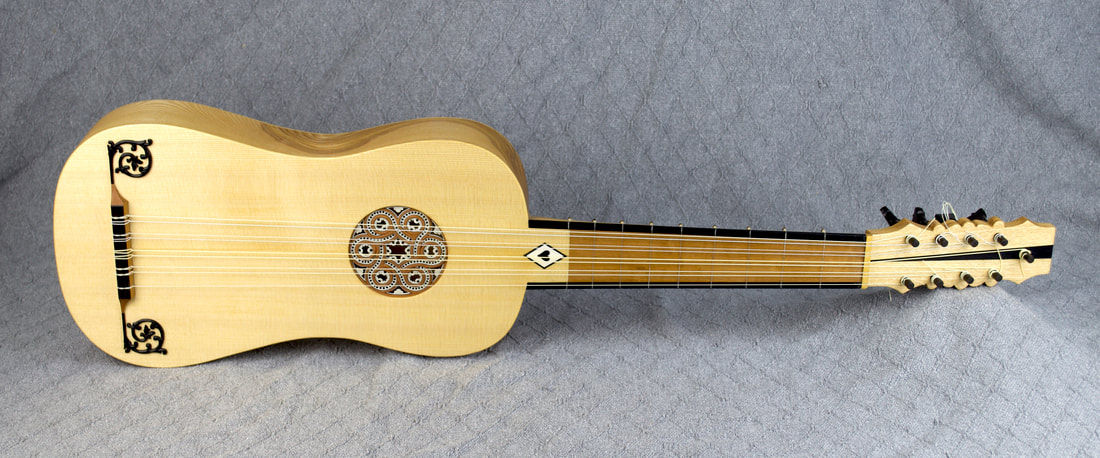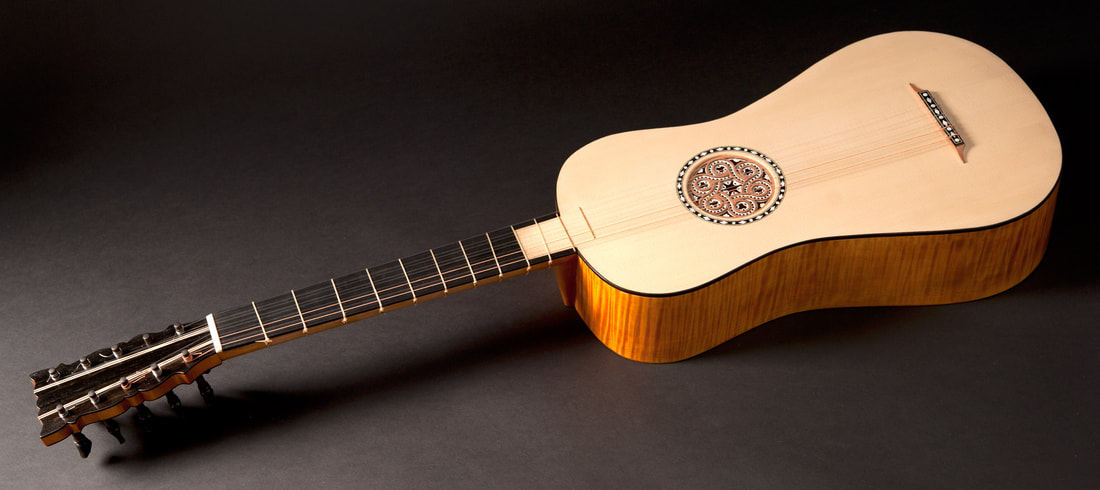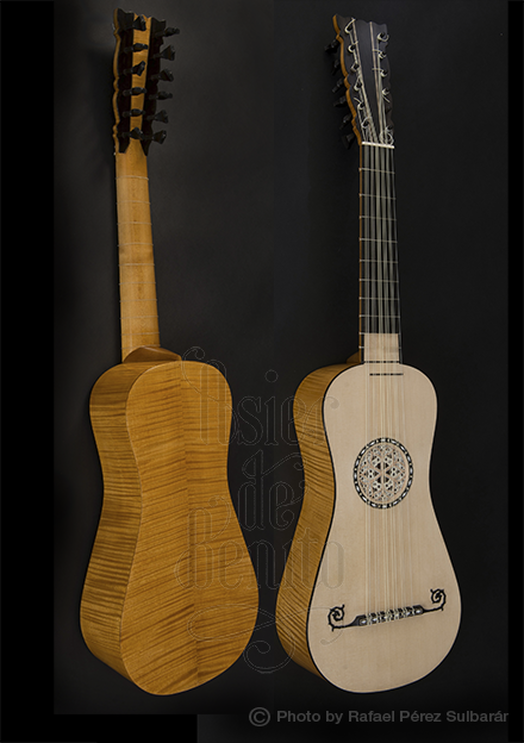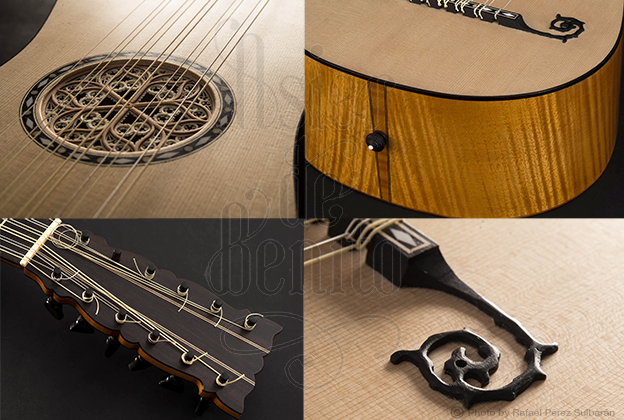5-COURSE GUITAR
At the end of the XVI century, while the vihuela de mano slowly falls into oblivion, guitar becomes the new protagonist, now with an incorporated fifth course, and with a form described by Joan Carles Amat in his tractate “Guitarra española de 5 órdenes”, in 1596.
Its technique, based first in rasgueados to play with dances, also inherited the vihuela complex plucking, thus gaining versatility and acceptance in musical circles throughout Europe.
Around 1650, it is attributed to the actor and musician Francesco Corbetta the dissemination of the instrument by the French court of Louis XIV, and from there it spread to the England of Charles II. Notable authors such as Gaspar Sanz, Santiago de Murcia, Jean-Baptiste Lully and Robert de Visée wrote pieces for guitar during the so-called Baroque period.
Its technique, based first in rasgueados to play with dances, also inherited the vihuela complex plucking, thus gaining versatility and acceptance in musical circles throughout Europe.
Around 1650, it is attributed to the actor and musician Francesco Corbetta the dissemination of the instrument by the French court of Louis XIV, and from there it spread to the England of Charles II. Notable authors such as Gaspar Sanz, Santiago de Murcia, Jean-Baptiste Lully and Robert de Visée wrote pieces for guitar during the so-called Baroque period.
5-COURSE GUITAR OR VIHUELA BASED ON BERMUDO
This instrument is based on the texts and illustrations of Fray Juan Bermudo's Declaration of Instruments (1555), a treatise in which he names and describes the 5-course vihuelas.
The body is carved and hollowed from a single piece of ash wood, with a spruce top. The fingerboard and bridge are made of pearwood and ebony. The soundboard decoration is made of recycled ivory from an old piano keys.
SL: 580mm.
Proposed tuning: aA-d'd-gg-bb-e'.
Price professional: €2700
Price intermediate: €2000
Price student: €1500
The body is carved and hollowed from a single piece of ash wood, with a spruce top. The fingerboard and bridge are made of pearwood and ebony. The soundboard decoration is made of recycled ivory from an old piano keys.
SL: 580mm.
Proposed tuning: aA-d'd-gg-bb-e'.
Price professional: €2700
Price intermediate: €2000
Price student: €1500
|
Emilio Villalba plays "Agujitas y alfileres", own composition, with this 5-course guitar. |
|
SPANISH 5-COURSE GUITAR
Design based on original by Joseph Massagué, 1758.
Pau ferro or rosewood sides. Cypress back. Spruce top with parchment rose. Cedar neck. Finished with oil and wax.
SL: 670 mm.
Proposed tunings: aa-d'd'-gg-bb-e' / aA-d'd-gg-bb-e'
Price professional: €3,200.
Price intermediate: €2,200.
Price student: €1,500.
Pau ferro or rosewood sides. Cypress back. Spruce top with parchment rose. Cedar neck. Finished with oil and wax.
SL: 670 mm.
Proposed tunings: aa-d'd'-gg-bb-e' / aA-d'd-gg-bb-e'
Price professional: €3,200.
Price intermediate: €2,200.
Price student: €1,500.
"La felicidad secreta", Manoel Macía (2021).
Played with a 5-course Massagué guitar, recorded in duet.
Played with a 5-course Massagué guitar, recorded in duet.
ITALIAN 5-COURSE GUITAR
Design based on originals by Antonio Stradivari.
Curly maple sides, back and neck. Spruce top with wood and parchment rose. Ebony and bone inlays. Ebony fingerboard and headstock. Finished with oil-based organic varnish.
SL: 670 mm
Proposed tunings: aa-d'd'-gg-bb-e' / aA-d'd-gg-bb-e'
Price professional: €3,200.
Price intermediate: €2,200.
Price student: €1,500.
Curly maple sides, back and neck. Spruce top with wood and parchment rose. Ebony and bone inlays. Ebony fingerboard and headstock. Finished with oil-based organic varnish.
SL: 670 mm
Proposed tunings: aa-d'd'-gg-bb-e' / aA-d'd-gg-bb-e'
Price professional: €3,200.
Price intermediate: €2,200.
Price student: €1,500.
ITALIAN 5+1-COURSE GUITAR
|
Design also based on Antonio Stradivari originals but this is a especial work for the Master guitarist Kazuhiro Yoshizumi.
Curly maple body and neck. European spruce top. Pear bridge with ebony and bone inlays. Pegbox, fingerboard and pegs made of ebony. 3-layer rosette in pear and parchment with an inlayed ebony and bone edging. Body finished with organic poliresinose alcohol varnish, from cremonese recipes. Top is finished with wax. Vibrating length is 650mm.
|
GUITAR / VIHUELA IN THE CONVENT OF LA ENCARNACIÓN
Model based on the instrument preserved in the Convent of La Encarnación (Ávila). According to the study carried out by Bosser, Martínez and Romanillos in 2009, it would be a recycled vihuela neck in a primitive baroque guitar body.
The result of my interpretation is an instrument that can be tuned as a vihuela in E or as a baroque guitar, with a simple modification of the strings.
SL: 650 mm.
Tuning: E-A-d-f#-b-e'
Price professional: €2,900.
Price intermediate: €2,200.
Price student: €1,500.
The result of my interpretation is an instrument that can be tuned as a vihuela in E or as a baroque guitar, with a simple modification of the strings.
SL: 650 mm.
Tuning: E-A-d-f#-b-e'
Price professional: €2,900.
Price intermediate: €2,200.
Price student: €1,500.





